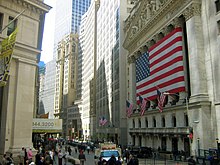Market capitalization: Difference between revisions
m Reverted edits by 201.130.10.94 (talk) to last version by Jprg1966 |
|||
| Line 43: | Line 43: | ||
* [http://www.macroaxis.com/invest/ratio/Market_Capitalization Market cap filter for global public companies] Free look up of current market capitalization |
* [http://www.macroaxis.com/invest/ratio/Market_Capitalization Market cap filter for global public companies] Free look up of current market capitalization |
||
* [http://marketcapitalizations.com/historical-data/historical-data-categories/valuations/ MarketCapitalizations.com] Historical market caps for companies from different countries |
* [http://marketcapitalizations.com/historical-data/historical-data-categories/valuations/ MarketCapitalizations.com] Historical market caps for companies from different countries |
||
* [http://trendeconomy.com/en/indicators/Market_capitalization Market capitalization of listed companies (% of GDP): statistics by country] |
|||
{{stock market}} |
{{stock market}} |
||
Revision as of 19:29, 9 May 2015
This article needs additional citations for verification. (February 2013) |

Market capitalization (or market cap) is the total dollar market value of the shares outstanding of a publicly traded company; it is equal to the share price times the number of shares outstanding.[2][3] As outstanding stock is bought and sold in public markets, capitalization could be used as a proxy for the public opinion of a company's net worth and is a determining factor in some forms of stock valuation. The investment community uses this figure to determine a company's size, as opposed to sales or total asset figures.
The total capitalization of stock markets or economic regions may be compared to other economic indicators. The total market capitalization of all publicly traded companies in the world was US$51.2 trillion in January 2007[4] and rose as high as US$57.5 trillion in May 2008[5] before dropping below US$50 trillion in August 2008 and slightly above US$40 trillion in September 2008.[5]
Since 2009, when Bitcoin became the first decentralized cryptocurrency and numerous cryptocurrencies (altcoins) have been created, the 'market cap' term has also come into common use to describe the total dollar market value of the total amount of cryptocurrency in circulation (available supply).[6][7] The term sometimes can refer to the estimated market value of the total amount of cryptocurrency that will ever be in circulation (total supply).[8]
How it is calculated
Market cap is given by the formula , where MC is the market capitalization, N is the number of shares outstanding, and P is the price per share.
For example, if some company has 4 million shares outstanding and the price per share is $20, its market cap is then $80 million. If the price per share rises to $21, the market cap becomes $84 million. If it drops to $19 per share, the market cap falls to $76 million.
Market cap terms
Traditionally, companies were divided into large-cap, mid-cap, and small-cap.[2] The terms mega-cap and micro-cap have also since come into common use,[9][10] and nano-cap is sometimes heard. Different numbers are used by different indexes;[11] there is no official definition of, or full consensus agreement about, the exact cutoff values. The cutoffs may be defined as percentiles rather than in nominal dollars. The definitions expressed in nominal dollars need to be adjusted over the decades due to inflation, population change, and overall market valuation (for example, $1 billion was a large market cap in 1950, but it is not very large now), and they may be different for different countries.
Related measures
Market cap reflects only the equity value of a company. It is important to note that a firm's choice of capital structure has a significant impact on how the total value of a company is allocated between equity and debt. A more comprehensive measure is enterprise value (EV), which gives effect to outstanding debt, preferred stock, and other factors. For insurance firms, a value called the embedded value (EV) has been used.
See also
- Free float
- List of finance topics
- List of corporations by market capitalization
- Market price
- Market trend
- Middle-market company
- Shares authorized
- Treasury stock
References
- ^ "Market highlights for first half-year 2010" (PDF). World Federation of Exchanges. Retrieved May 29, 2013.
- ^ a b "Market Capitalization Definition". Retrieved April 2, 2013.
- ^ "Financial Times Lexicon". Retrieved February 19, 2013.
- ^ Global stock values top $50 trln: industry data (Reuters)
- ^ a b WFE Report Generator including report for Domestic Market Capitalization 2008 (World Federation of Exchanges)
- ^ "Litecoin Spikes 200 m market capitalization". Retrieved November 20, 2013.
- ^ "Cryptocurrency Market Cap (available supply)". Retrieved April 19, 2015.
- ^ "Cryptocurrency Market Cap (total supply)". Retrieved April 19, 2015.
- ^ "Mega Cap Definition". Retrieved April 2, 2013.
- ^ "Micro Cap Definition". Retrieved April 2, 2013.
- ^ Definition of Market Capitalization
This article needs additional citations for verification. (January 2008) |
External links
- How to Value Assets – from the Washington State (U.S.) government web site
- Year-end market capitalization by country – World Bank, 1988–2010
- Equity and Bond Capitalizations G20 – Equity and bond capitalization for the G20
- Comparative Explanation – Share Count: Authorized, Outstanding And Float
- Market cap filter for global public companies Free look up of current market capitalization
- MarketCapitalizations.com Historical market caps for companies from different countries
- Market capitalization of listed companies (% of GDP): statistics by country

